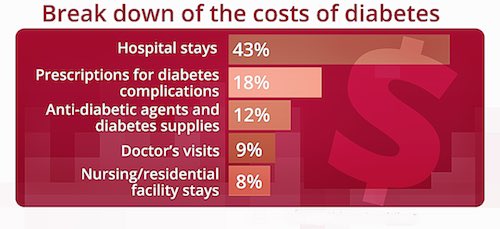
Diabetes isn’t especially expensive because it causes nothing. But uncontrolled diabetes can be one of the most expensive diseases anybody can get.
The visits you have to make to your doctor, the blood glucose meters that you require to check your level, and the prescription medications that most people with diabetes need are only a small part of the economic costs of diabetes. But all together, these essential components of diabetes management were just one-third of the estimated direct costs of diagnosed diabetes in 2012, the most recent year for which we have data.
When diabetes gets expensive
Diabetes does start to get expensive when you don’t manage it and have to be hospitalized or need to go into a nursing home or residential facility. This amounts to more than half of the direct cost.
But this doesn’t even count the indirect cost, which is 28 percent of the total cost. The indirect cost includes missing work because of illness, reduced productivity at work and at home, unemployment from chronic disability, and premature death. And there’s even more, because “omitted from the cost estimates are the intangible costs of diabetes such as pain, suffering, and reduced quality of life.”
In 2012, people with diagnosed diabetes spent about $13,700 for their health care. Of this amount, about $7,900 is directly attributed to the disease.
Uncontrolled diabetes costs $211,000
Another study recently calculated the lifetime cost that people with diabetes typically pay. The “excess lifetime medical spending for people with diabetes” is now more than $211,000.
Of course, you can forget these scary statistics if you manage your diabetes, instead of letting it manage you. Managed diabetes basically means doing what it takes to have a normal blood glucose level.
The A1C test is the best tool we have to check that level. This simple test tells you and your doctor the proportion of a type of your red blood cells that have glucose stuck to them rather than getting to the muscle and brain cells that need it. A normal A1C level is when you have 6.0 percent or less of this blood stuck to glucose. When you manage your diabetes this well, you aren’t more likely to get any of the complications of diabetes than people without diabetes would suffer.
Most people who have diabetes need each of the four pillars of diabetes support to manage it.
In addition to eating better, becoming more active, and reducing stress, you typically need to get a prescription from your doctor for medication.
A new and powerful diabetes drug
One of the newest and most powerful of these medications for people with type 2 diabetes is the class called non-insulin injectables or GLP-1 receptor agonists. They aren’t insulin, which people with type 1 diabetes have to use. You inject one of them like you would if you were on insulin, and the most recent of the medications in this class requires only one injection per week.
These new medications mimic the action of our body’s GLP-1 hormone, but have a much longer effectiveness than it does. These non-insulin injectables stimulate the release of our body’s natural insulin, and have many more positive effects.
These include reducing glucagon, slowing gastric emptying, and inducing satiety. They have a low risk of hypoglycemia, help to reduce blood pressure, improve cholesterol and triglyceride levels, often lead to substantial weight loss, and — most importantly — lead to significant reductions in A1C.
Like any prescription medication, they aren’t free. But if you have health insurance, it will undoubtedly cover almost all of the cost. If you had uncontrolled diabetes, your costs as well as your pain and suffering would be far greater.
This article is based on an earlier version of my article published by HealthCentral.
Never Miss An Update
Subscribe to my free newsletter “Diabetes Update”
I send out my newsletter on first of every month. It covers new articles and columns that I have written and important developments in diabetes generally that you may have missed.


When you fall into the donut hole, as I did in March, the personal costs of diabetes sky rockets. Humalog, Novo, Levemir and probably Lantus, are now close to $300 a vial. I assume Humalin R and N costs are much lower, but they do not offer the best control. Aside from getting diagnosed and held in the hospital until they trained me, with insulin, and lowered my bgs by 400 points, I have never been hospitalized, gone to the ER, or an urgent care because of my diabetes. Nevertheless it took more than a couple of years to get a diagnosis, when I ran with very, very high sugars and set the stage for later complications. I have neuropathy. Use Lyrica – very expensive. No heart disease, eyes not damaged (pycnogenol and grapeseed) and I still have a brain.